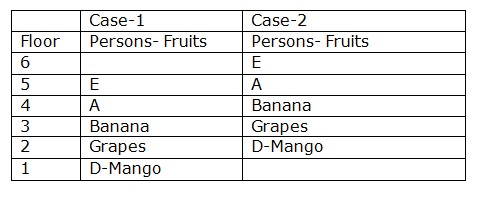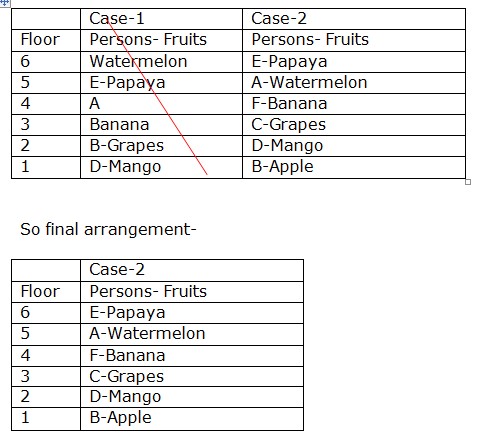Question
Who among the following person likes banana?
Study the following information carefully and answer the questions given below. Six persons – A, B, C, D, E and F are living in a six-storey building, but not necessarily in the same order. They like different fruits – Mango, Apple, Grapes, Banana, Papaya and Watermelon. The lower-most floor is numbered as 1 and the floor immediately above is numbered as 2 and so on. Only two persons live between the one who likes grapes and E, who lives above the third floor. D lives immediately below the one who likes grapes. The one who likes banana lives two floors above D. A lives three floors above the one who likes mango. A doesn’t like banana. No one lives between the one who likes papaya and watermelon. Only three persons live between B and the one who likes watermelon. The one, who likes mango, lives on the adjacent floor of C.Solution
We have, Only two persons live between the one who likes grapes and E, who lives above the third floor. D lives immediately below the one who likes grapes. From this condition, there are two possibilities  Again we have, The one who likes banana lives two floors above D.A lives three floors above the one who likes mango. A doesn’t like banana.
Again we have, The one who likes banana lives two floors above D.A lives three floors above the one who likes mango. A doesn’t like banana.  Again we have, No one lives between the one who likes papaya and watermelon. Only three persons live between B and the one who likes watermelon. The one, who likes mango, lives on the adjacent floor of C. From the above condition, case 1 gets eliminated. hence, case 2 shows the final arrangement.
Again we have, No one lives between the one who likes papaya and watermelon. Only three persons live between B and the one who likes watermelon. The one, who likes mango, lives on the adjacent floor of C. From the above condition, case 1 gets eliminated. hence, case 2 shows the final arrangement. 
- What approximate value will come in place of the question mark (?) in the following question? (Note: You are not expected to calculate the exact value.)
99.99% of 9.99 + 299.98% of 129.98 = ?2
456.9 + 328.10 - 122.98 = ? + 232.11
- What approximate value will come in place of the question mark (?) in the following question? (Note: You are not expected to calculate the exact value.)
What approximate value will come in place of the question mark (?) in the following question? (Note: You are not expected to calculate the exact value.)...
The average marks of 15 candidates were reported as 84. However, it was later discovered that the marks of three candidates were ...
What approximate value will come in place of the question mark (?) in the following question? (Note: You are not expected to calculate the exact value.)...
15.15% of (150.50 + 249.50) + 8.08³ - (10.10 of 5.05) = ? of (75.75 - 25.25)

A motor boat goes downstream from point A to B ,which is 36 km away from point A, and then returns to A. If actual speed of the boat in still water is 7...
Relevant for Exams:


